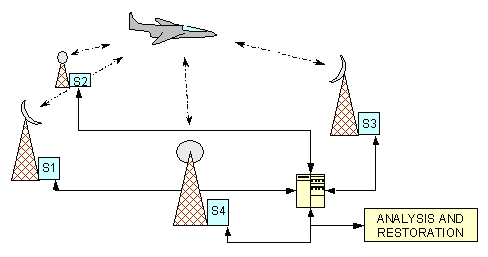Example
The Multitask Noisy Speech Enhancement System has been applied to recording and restoration of the radio communication between aircraft pilots and the ground control stations. The quality of speech signal in such communication is often low, due to noise in the pilot's cabin and changing conditions of radio waves propagation. These factors result in introducing the noise, hiss, sound dropouts and other distortions to the signal, which may greatly deteriorate speech intelligibility. Moreover, currently used methods of acquisition and recording of radio communication between pilots and ground control stations do not fulfil modern technological requirements.
Efficient speech recording system and possibility to improve intelligibility of radio communication recordings are crucial when a crash accident is investigated and are useful in the process of pilots training. Therefore, the system described on this website was implemented for:
- hard disk recording of the radio communication (only speech signal is recorded),
- archiving, managing and analysis of the recorded communication,
- digital processing of the recorded signals using a set of developed tools for improving the speech intelligibility.
The most important feature of the system is simultaneous recording of the radio transmission from multiple sources. In the applied system, the signal is recorded by the Recorder applications running on computers connected to four radio stations in different ground control centres. These multiple versions of recordings are used by the Browser application for multichannel playback using the surround sound system situated in the laboratory room. This, way, better listening conditions are obtained and speech intelligibility is improved. The speech recordings may be previously processed using a set of procedures available in the Restorer application.
The central part of the system is a dedicated server which collects the recordings from all stations and controls the function of the whole system. The radio communication is constantly recorded in all stations, controlled by the operator. If any part of the recorded material is classified by the operator as 'important' (an accident occurred or the recording may be useful for pilots training), the recorded sound files are marked. All non-marked sound files are automatically deleted from disk by the application after 48 hours. The marked sound files are encrypted and uploaded to the server using the Internet connection. The searchable database that runs on the server collects data on all recordings sent to the server and stored on its disk. The recordings made at the same time in all stations may be downloaded from the server by the Browser application on a computer in the laboratory room, decrypted and used for restoration and multichannel playback.
Block diagram of the system (S - recording stations)

The server also controls the function of the system. A special Internet communication protocol was developed to enable exchanging messages between the server and the recording stations. Every station has to log in to the server when the Recorder application is started and log out when the application is shut down. All stations that are logged in receive important messages from the server. The server stores information on the state of each station, e.g. whether the recording was started in a station. These information are available to the system administrator by the WWW interface. The server also synchronises system clock in each station.
The interactive Flash animation below presents the function of the whole system. Click the buttons in order to see how different parts of the system work. Click here to see larger version of the presentation in the separate window.
The recorded speech signal are processed by the Restorer application using a chain of digital signal processing procedures, in order to improve speech intelligibility. The choice of the procedures used in the restoration process, their order and parameters has to be made by the user. Here are two examples of real recording of radio communication and results of multi-stage processing using various algorithms. Click on the speaker icon to hear the sound.
Example 1 (in Polish)
| Step 0 | Original sound |
 |
| Step 1 | Noise reduction |
 |
| Step 2 | Speech band equalizer |
 |
| Step 3 | Noise whitening |
 |
| Step 4 | Time stretching |
 |
|
Example 2 (in English)
| Step 0 | Original sound |
 |
| Step 1 | Noise reduction |
 |
| Step 2 | Speech band equalizer |
 |
| Step 3 | Noise whitening |
 |
| Step 4 | Blind deconvolution |
 |
|
The Multitask Noisy Speech Enhancement System is used in Department of Aviation, Air Force Academy in Deblin, Poland. The current research aims to find optimal order of restoration procedures and their settings that yields best results for different types of signal distortions.
---
The system was presented during the 116th Audio Engineering Society Convention in Berlin, Germany, 8-11 May 2004. Preprint No. 6126 may be ordered from the AES website.
|